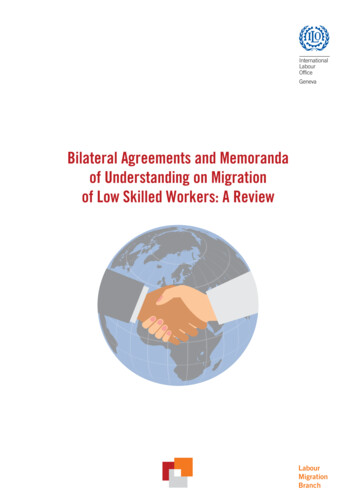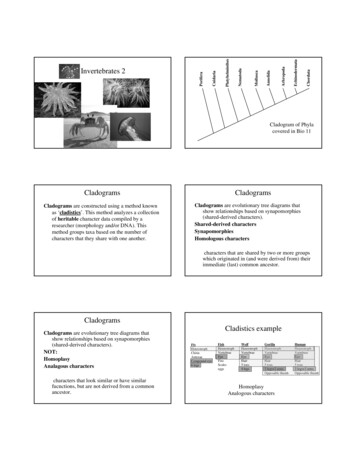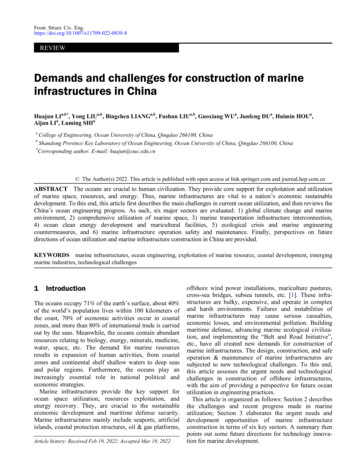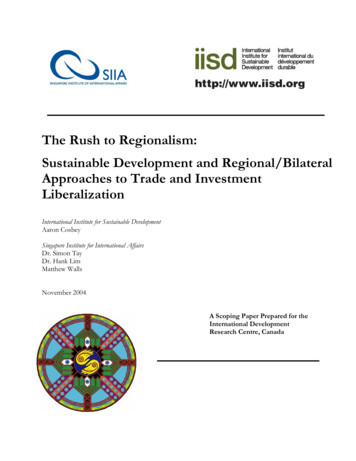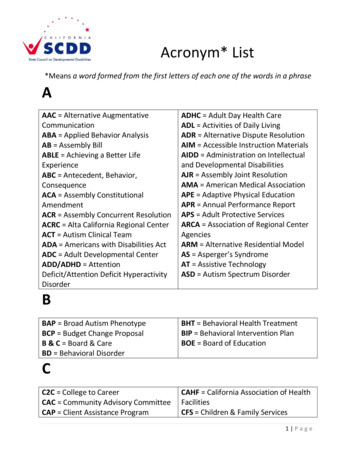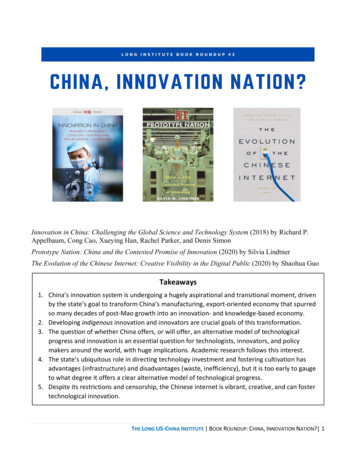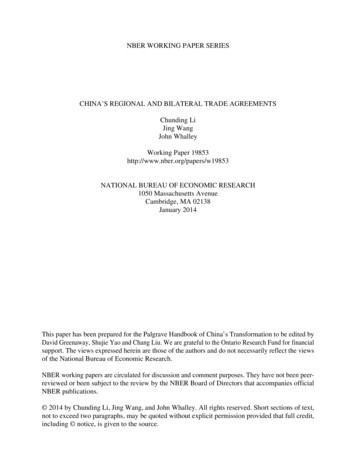
Transcription
NBER WORKING PAPER SERIESCHINA’S REGIONAL AND BILATERAL TRADE AGREEMENTSChunding LiJing WangJohn WhalleyWorking Paper 19853http://www.nber.org/papers/w19853NATIONAL BUREAU OF ECONOMIC RESEARCH1050 Massachusetts AvenueCambridge, MA 02138January 2014This paper has been prepared for the Palgrave Handbook of China’s Transformation to be edited byDavid Greenaway, Shujie Yao and Chang Liu. We are grateful to the Ontario Research Fund for financialsupport. The views expressed herein are those of the authors and do not necessarily reflect the viewsof the National Bureau of Economic Research.NBER working papers are circulated for discussion and comment purposes. They have not been peerreviewed or been subject to the review by the NBER Board of Directors that accompanies officialNBER publications. 2014 by Chunding Li, Jing Wang, and John Whalley. All rights reserved. Short sections of text,not to exceed two paragraphs, may be quoted without explicit permission provided that full credit,including notice, is given to the source.
China’s Regional and Bilateral Trade AgreementsChunding Li, Jing Wang, and John WhalleyNBER Working Paper No. 19853January 2014JEL No. F15,F60ABSTRACTChina has been increasingly active on the regional trade agreement front over since WTO Accessionoccurred in 2001. These agreements, unlike the US and EU cases, follow no template form of agreementbut vary substantially one among the others and are in part an attempt to customize agreements topartner prior agreements. There are presently 12 concluded agreements, 6 under negotiation, and fourothers under consideration. These concluded are in the main with smaller countries. Those in prospectare with major trading areas (US, Japan, Korea, and India). All are driven in part by China’s needsfor export access to fuel continuing export lead growth, but other elements enter including using regionalagreements to offset unwelcome elements of multilateral arrangements (such as the non-market economylabelling), and attempting to put in place via RTA building blocks an Asian trading hub. Outstandingissues not centrally addressed by these agreements include anti-dumping duties, and investment andcompetition issues.Chunding LiInstitute of World Economics and PoliticsChinese Academy of Social SciencesNo.5 JianguomenneidajieBeijing, PRCPostcode: 100732chundingli@gmail.comJing WangDepartment of EconomicsSocial Science CentreUniversity of Western Ontario1151 Richmond St.London, ON, N6A 5C2CANADAwangj.uwo@gmail.comJohn WhalleyDepartment of EconomicsSocial Science CentreUniversity of Western OntarioLondon, ON N6A 5C2CANADAand NBERjwhalley@uwo.ca
1. IntroductionIn 2001 China acceded to the WTO driven in large part by the view thatintegration into the world economy was central to China’s development ambitions inhelping provide improved access to key export markets. There has since beenconsiderable debate over whether the terms of WTO accession provided much by wayof concrete improvement in access commitments by trading partners beyond thetechnical firming up of MFN by trading partners which some have argued that Chinaalready defacto enjoyed. Instead, the claim is often made that the more importantimpact of WTO accession was in terms of underpinning domestic market orientedreforms and establishing clearer rules of law internationally which proved key infueling large increase in foreign direct investment which, in turn, fueled growth inboth GDP and exports.But China’s efforts at international economic diplomacy have not stopped atWTO accession, and since accession China has been increasingly active in its pursuitof regional and bilateral trade agreements. Since 2001 China has concludedagreements with 12 different entities (both countries and groups of countries), has 6other under negotiation, and 4 under consideration. While that is a similar picture toelsewhere in Asia (Japan, Korea, for example), the picture in the Chinese case is ofinitial agreements focusing on local (Hong Kong) or smaller entities (Iceland, forexample) that were easier to negotiate, before moving to larger and moreconsequential agreements (with ASEAN, for instance). Agreements now underconsideration emphasize large country arrangements and are more important for3
China. These include a possible China-US FTA, possible participation in the TransPacific Partnership negotiation with 12 other Pacific countries, a bilateral agreementwith India, and a trilateral China-Japan-Korea agreement.China is not alone in pursuing a network of bilateral trade agreements. But China,more than any other larger economy reflects the need to attempt to enhance exportaccess in this way. While export growth which has been falling since the financialcrisis and in May 2013 turned negative, given export oriented growth is still the norm,access driven negotiation and bilateralism logically follow. In what following weargue not only that this strategy is now poised to enter a new stage of negotiation withlarge partners (using TPP, India), but also that China could benefit from a clearerfocus on access related problems in such negotiation. Included in the list areanti-dumping duties, which we discuss in more detail, and where China facescontinuing problems.2. China’s Regional and Bilateral Trade StrategyChina clearly sees both Regional and Bilateral Trade Agreements (RTAs) as anincreasingly key element of its integration into the global economy, a broader strategywhich still underpins her overall growth strategy. The current focus of suchagreements is mainly on Asia, and to a further degree the Pacific. The basic idea is touse RTAs to further open up the economy to the outside world and speed up domesticreforms. They are seen as strengthening economic cooperation with other economies,as well as providing a supplement to the WTO based multilateral trading system at atime when given the post Doha Rounds impasse, major progress in the WTO on4
access seems unlikely.As Table 1 indicates, China has 12 RTA partners (and with 33 separate economies)with which 11 Agreements have already been signed. These 12 partners are theAssociation of Southeast Asian Countries (ASEAN), Pakistan, Chile, New Zealand,Singapore, Peru, Hong Kong, Macao, Taiwan, Costa Rica, Iceland, and Switzerland.Appendix I to the paper itemizes and gives more details on each of these along withnegotiation in progress and in prospect.Table 1: China’s RTAs1. Existing RTADate ConcludedChina-PakistanNovember 2006China-Chile RTAChina-Peru FTABilateral-with Developing CountriesNovember 2005April 2009China-Costa Rica FTAApril 2010China-New Zealand FTAApril 2008China-Singapore FTAChina-Iceland FTABilateral-with Developed CountriesChina-Switzerland FTAChina-ASEAN FTAApril 2013July 2013MultilateralNovember 2004CEPAECFAOctober 2008March 2003Domestic FTAsJune 2010China Pilot Free-trade ZoneSeptember 20132. RTAs Under NegotiationNegotiations Started fromChina-Australia FTAChina-Norway FTAMay 2005Bilateral-with Developed CountriesSeptember 2008China-South Korea FTAMay 2010China-GCC FTAJuly 2004China-Japan-South Korea FTAMultilateralAugust 2013RCEPMay 20133. RTAs Under ConsiderationJoint FeasibilityStarted fromChina-India RTA2003China-Columbia FTABilateralMay 2012China-US FTAChina-TPP FTAStudyNot YetMultilateralNot YetSource: Compiled by authors.Most of the existing RTAs are bilateral and most partners are from Asia andbelong to developing countries or country groups. Within the group of existing5
agreements, the China-ASEAN FTA, CEPA (Hong Kong Macro) and ECFA (Taiwan)are important RTAs since they involve partners with whom there is large trade. OtherRTAs including both developed countries and developing countries are with smallcountries. China’s RTAs under negotiation on consideration mainly involve largepartners (US, TPP (12 Trans Pacific Partner countries), RCEP, Japan, Korea andIndia).Access for ExportsSince the opening of China to the outside world in 1992 following Deng XiaoPing’s Southern tour, exports have grown rapidly from China. Today around 70% ofall goods manufactured in China are exported and manufacturing, while now smallerthan services still accounts for nearly 40% of GDP and a similar proportion ofemployment. Since the early 1990’s GDP growth has averaged 10% per year evenwith the lowered growth rates since the financial crisis of 2008. Continued exportgrowth is thus seen as vital to China in order to continue with high GDP growth, andin recent years export growth which touched 30% a year before the financial crisis hasbeen in the 3-4% range. With a WTO negotiation structure seemingly not yieldingmuch by way of improved access, RTAs seem to offer the most fruitful alternative andhence are being actively embraced by China.While China’s regional trade agreements thus far concluded are mainly withsmall developing or developed countries, prospective agreements under discussion arewith large countries and China’s RTA strategy is to move from RTA coverage ofperhaps 30% of trade to 70% of trade marking the growing importance of RTAs to6
China. As such, they clearly reflect the dominant export interest of China in the formof search for access to foreign markets.Domestic ReformAnother reason China seeks to negotiate RTAs is to continue to use internationaldisciplines to underpin and support domestic reforms, including enterprise reform,reform of state owned enterprises, financial sector reform and others reformistdirections. The broad idea is that added competition from abroad in the domesticmarket acts as a spur to improved efficiency of domestic production. In addition,pressures for protectionist and growth slowing policy interventions can be more easilyresisted emphasizing again the need to compete with foreign producers both at homeand abroad. This domestic policy component of trade policy was a key element inChinese decision making to join the WTO in 2001, and it continues as a key elementin underpinning China’s RTA strategy.Dealing with Issues in the Multilateral SystemAnother Chinese objective in RTA negotiation is to use RTAs as a way ofimproving on their current treatment multilaterally under the WTO. Two major issuesstand out here. One is China’s labelling under WTO Accession as a non-marketeconomy. This label, to which China agreed on Accession, has made it both easier toimpose antidumping actions against China, and if imposed to do so at (often much)higher duty rates. China has thus used a strategy in her RTA negotiation of bilaterallyseeking reclassification as a market economy regionally. This strategy has beensuccessfully followed in China’s negotiations with New Zealand. Another is the broad7
area of antidumping duties. Because China’s growth of exports has been so rapid,domestic producers in importing countries seek protection and antidumping duties areoften the most effective route for them to pursue. These are special trade restrictionsdesign as to offset alleged unfairness in trade from selling below cost. China is nowsubject to around 50% of worldwide dumping actions (many from other developingcountries)1 while WTO disciplines under the General Agreement on Tariff and Trade(GATT) do little to help China. China seeks relief, and bilateral arrangements (jointexemptions from dumping and sunset procedures) could help.Framing New Trade RulesSince the 2008 financial crisis trade there has been much discussion of theexperience of developing countries with current multinational organizations and ruleregimes (World Bank, WTO, IMF). These were framed in the 1940’s and weredesigned to deal with wholly different problems from those today’s trading systemfocuses on. Some argue they do not fit the modern world economy, and global rules,including in trade, should be reassessed in light of the difficulties in the WTO Doharound. These have reflected developing country frustration with what they often seeas a “rich men’s club”. As such, a further objective China has in participation in RTAs(also including the large country RTAs now being discussed) is to use new RTAstructures to help shape the evolution of future global trade rules and arrangements.3. Characteristics of the RTA Strategy1See the discussions in Bown (2009), “Self-enforcing Trade: Developing Countries and WTO DisputeSettlement”, Brookings Institute; Bown (2010), “China's WTO Entry: Antidumping, Safeguards, and DisputeSettlement”, and Bown (2011) “Taking Stock of Antidumping, Safeguards and Countervailing Duties,1990–2009”.8
China’s RTA negotiating strategy has been marked by a number of characteristicswhich can be seen in the documentation in the Appendix. These include the following.Begin Local / SmallChina’s strategy has been framed from an initial situation of no regionalagreements at the time of WTO accession in 2001. China’s strategy was to begin localand small, in part reflecting the ease of negotiation and also the learning experiencesinvolved in sequential negotiation. The first RTA was with Hong Kong and Macro in2003, and the first developed country RTA was with New Zealand in 2008. With thenotable exception of the ASEAN agreement, all of the first 12 China’s RTAs havebeen with relatively small trading entities. In this way, it is easier to achieveprecedents in coverage and for later negotiation, as well as pursuing new initiatives.China’s RTAs in this initial group also show more variation than is true of US or EUregional agreements. US regional agreements typically offer accelerated tariffelimination bilaterally in return for what is effectively unilateral service liberalizationby the partner. EU agreements emphasize legal structure and competition law andhave partners progress through a graduation of agreements before achieving a fullFTA. Chinese agreements are in contrast more varied by partners.Aim to be Inclusive of Key WTO MembersBy beginning small and local, China’s FTA strategy has implicitly set a goal ofaiming to eventually be inclusive of most key WTO members. The list includes theUS, the EU, and India, all major trading partners of China. A bilateral agreement withIndia is the subject of a joint feasibility study, but for now remains blocked by Indian9
manufacturing interests who fear loss of domestic markets. This strategy has enabledChinese negotiations to learn about the negotiating process and also gives China thestrategic benefits in delaying US/EU negotiation bilaterally until other arrangementsare in place. The effective trilateral China/US/EU negotiation which seems likely tohappen in the next few years will also help shape the system of trade rules which willguide the world economy in the decades to come, and China through its large countryRTAs will have played a major role in this.BITs as Separate TreatiesA further feature of China’s FTAs has been their linkage to bilateral investmenttreaties (BITs). There are near 3000 BITs in place today as negotiated bilateralagreements covering dispute settlement over investment related matters, guaranteeson repatriation of funds for investors, expropriation limits and other matters. Thesenegotiations typically either predate or follow a full RTA as a separate negotiation andit has been notable in the Chinese case how this separateness has been the norm.Currently for the initial China-Japan-Korea RTA negotiation there is a prior tri initialinvestment treaty negotiation. BITs negotiations do not typically, however, deal withthe rules governing investment flows, including MFN, and so given China’s interestnow in outward foreign investment a broadening in approach would seem to be in theChinese interest.Customize RTAs to PartnerAs already noted the Chinese approach to RTAs has not been to adopt a template,one size fits all, approach to all RTAs. Instead, diversity seems more the norm. This10
reflects a Chinese negotiating strategy that by fitting into the preferred broad structureof the partner more can be obtained in the detail of the negotiation. Thus theChina-ASEAN agreement devotes considerable coverage to broad commitments ofcooperation in development in general. These broad political commitments are inaddition to precise and concrete commitments on tariff issues. In the New Zealandagreement in contrast there is less focus on developmental cooperation and more ontargeted precise commitments, given New Zealand’s developed country status.4. Some Features of Key ArrangementsArrangements in PlaceAmong the already negotiated agreements the key RTA agreements are withASEAN and with Hong Kong/Macao. The Hong Kong/Macao agreements are notablein several areas. One is a bilateral agreement to exempt each other from their ownantidumping duty arrangements. This is similar to the bilateral exemption in theAustralia-New Zealand Closer Economic Relationship RTA. Another is a specialarrangement introduced for Hong Kong service companies in their operations inmainland Chinese market. The ASEAN agreement is notable in yielding the largestinternal market of 1.7 billion people in one RTA arrangement in the world. At thesame time, however, China and ASEAN have more competition in joint countrymarkets (EU) than joint bilateral trade, and hence the focus on economic cooperationmechanisms, in part, for coordinating in third country markets.Arrangements to ComeThe arrangements potentially to come for RTAs with the US, with Japan/Korea,11
with India and with the TPP countries suggest major potential impact on China’s tradeand international arrangements generally. The US has, in recent years, repeatedlylabeled China as a “currency manipulator” and claimed China keeps an artificiallylow exchange rate leading to large Chinese trade surpluses. The effective 25%appreciation of the RMB since 2005 has done much to eliminate the large tradesurplus, but US concerns remain. US objectives in a bilateral RTA would also involvenew rules in trade for state owned enterprises, and heightened enforcement ofintellectual property agreements. The Japan/Korea negotiation may be the moststraight forward in economic terms because the joint focus on economic growth,especially given China’s trade deficit with Japan, but political frictions between Chinaand Japan and specially the island dispute threaten to slow the negotiation. India hasseen rapid growth in its trade with China (by a factor of 30 since the mid-90s) and sothe prospects are for a significant RTA, made complex to negotiate by protectionistpressures on the Indian side. The transpacific partnership situation is one whereChinese participation is neither assumed nor yet sought from the Chinese side.5. Possible Impacts of RTAs for ChinaHow much will China’s RTAs, and especially prospective RTAs, impact onChina’s growth, trade and overall economic performance. By including all of China’smajor trading partners in RTAs and with an average current tariff of 10% to bereduced to zero the medium term impact of the RTA strategy could be substantial as aone off increment to trade growth.China’s problem remains how to keep elevated growth of trade for perhaps 212
decades while China continues to grow. Under this strategy, the one off contributionof RTAs seems welcome and not inconsequential, but in the long run not the singlesolution to growth. Much debate currently surrounds growth strategies in China withthe prevailing view being the need to promote domestic consumption growth toreplace trade growth as the engine of developments. In this sense of helping with thetransition to a new growth strategy, RTAs perhaps take on more significance.In terms of overall growth impacts China also faces a situation post the 2008financial crisis of not being able to continue to rely on infrastructure spending as thelatest growth source to replace trade when growth has slowed. The most rapidcomponent of China’s trade growth is with other Southern countries (India, Brazil)and RTAs can have a further positive impact in promoting the most dynamiccomponents of China’s trade.Several researchers have explored various dimensions of China related potentialRTAs. For the China-Japan-Korea FTA, Liu et al (2012) have investigated theenvironmental impacts of China-Japan-Korea FTA on China with CGE methodology,and find that a China-Japan-Korea FTA will lead to a notable environmental impact.Jin et al (2006) evaluate the economic effects of FTA among China, Japan, and SouthKorea on the world economy. Results show that there are strong trade diversioneffects.For the ASEAN 3 FTA, Loke (2013) examines the likely industry effects onChina of ASEAN Plus Three (APT), and find that there might be opportunities foragriculture industries fishery to expand. Some manufacturing industries like textiles13
and clothing are likely to expand even further. However, motor vehicles may facechallenges given that Japan and Korea are much more developed in this area.Siriwardana and Yang (2007) analyzed the impact of the proposedAustralia-China FTA. Their results suggest that both Australia and China will gain byremoving protection on trade bilaterally. The benefits are greater for Australia thanfor China. Patricio (2011) has also explored Australia-China FTA effects.For the TPP, Li and Whalley (2013) have explored the TPP effects on China andrelated other countries, the results reveal that China will be slightly hurt by TPPinitiatives in welfare when China is out, but total production and exports will increase.If China takes part in TPP, she will significantly gain and increase other TPPcountries’ gain as well. Petri et al (2011) has also investigated the potential effects ofTPP and other Asia FTAs.For the China-Pakistan FTA, Shabir and Kazmi (2007) have analyzed theeconomic effects of the Pakistan-China FTA, and reveal that this will enhanceinterregional trade and export diversification by further deepening cooperation withChina.Other literature include Choi (2013) has analyzed the effects of Korea-ChinaFTA, Tan and Li (2009) explore the impact of China-New Zealand FTA.14
Appendix: China’s RTA Agreements11. China’s Existing RTA Agreements(1) CEPA (Mainland China with Hong Kong and Macao)Mainland China and Hong Kong CEPA (Closer Economic PartnershipArrangement) was the first Chinese RTA. It was signed on 29 June 2003 and Macaosigned the pact in October 2003.2For Trade in goods, Hong Kong continues to apply zero tariffs to all importedgoods of Mainland origin. In the beginning of CEPA enforcement, the Mainlandapplied zero tariffs to 273 kinds of the import of goods of Hong Kong origin. Since 1January 2006, all goods of Hong Kong origin importing into the Mainland enjoy tarifffree treatment, upon application by local manufacturers and upon the CEPA rules oforigin (ROOs) being agreed and met. 3 The two sides undertake that either side willnot apply anti-dumping measures to goods imported and originated from the otherside.For trade in services, mainland China issued various liberalization measuresunder CEPA which provides Hong Kong service suppliers with preferential access tothe Mainland market. Under CEPA Hong Kong service suppliers receive preferentialaccess to the Mainland market. The preferential treatment takes various forms,including allowing wholly-owned operations, relaxing restrictions on equityshareholding, reducing registered capital requirements, relaxing restrictions overgeographical location and business scope, etc. 4 Since 2004, mainland China hasissued 41 liberalisation measures covering 18 service areas, and this increased to 338measures by 2013.5 Professional bodies of Hong Kong and the regulatory authorities1The majority of China’s Regional and Bilateral Trade Agreements (RTAs) are labeled as Free Trade Agreements(FTAs). When discussing individual agreements we keep the label used in the legal e /speeches/201308/20130800271162.shtml.15
in the Mainland have also signed a number of agreements or arrangements on mutualrecognition of professional qualification. 1Both sides also agreed to enhance co-operation in various trade and investmentfacilitation areas to improve the overall business environment. These includesCustoms Clearance Facilitation; Commodity Inspection and Quarantine, Food Safety,Quality and Standardization; Cooperation of Small and Medium-Sized Enterprises(SMEs); Cooperation in Industries; Electronic Business; Trade and InvestmentPromotion; Transparency in Laws and Regulations; Protection of Intellectual Property;Cooperation on Branding; and Cooperation on Education.2The outward direct investment from mainland to Hong Kong in 2012 was 35.6billion USD, double than it was in 2007. Hong Kong and mainland China are thelargest trading partners for each other, with total trade amounting 341.49 billion USDin 2012, which is 3 folds larger than as in 2003 (87.44 billion USD). Hong Kong alsokeeps the position of the largest source and recipient of investment for mainland.3(2) ASEAN-China FTAThe ASEAN – China Free Trade Area (ACFTA) is a free trade area among theten Member States of the Association of Southeast Asian Nations (ASEAN) andChina. The initial Framework Agreement (FA) was signed on 04 November 2002.The ASEAN–China Free Trade Area is the largest free trade area in terms ofpopulation and third largest in terms of nominal GDP.Under the ASEAN – China Trade in Goods Agreement (ACTIGA), Partiesreduced their tariffs for goods listed under the Normal Track 1 (NT1) from 2005-2010and Normal Track 2 (NT2) from 2010-2012. China allowed ASEAN Member Statesto have a list of products that were granted flexibility until 2012 (NT2) for 150 tarifflines. For the Philippines and Indonesia however, 400 tariff lines were accordedflexibility. The Sensitive Track under the ACFTA consists of a “Sensitive List” (SL)and the “Highly Sensitive List” (HSL). The timeframe for SL requires tariffs to bereduced to 20% in 2012 and shall be subsequently reduced to 0-5% in 2018. For vices/trade acilitation/summary eeches/201308/20130800271162.shtml.16
tariffs will be reduced to 50% in 2015. With these tariff cuts, the average tariff levelsunder the FTA have declined to 4.5%, compared with the MFN rate of 8.1%. InChina’s case, the overall simple ad valorem average for 2009 under the ACFTA is2.5%, compared with the 9.7% MFN rate.1 The average tariff rate on Chinese goodssold in ASEAN countries decreased from 12.8% to 0.6% on 1 January 2010 pendingimplementation of the free trade area by the remaining ASEAN members. Meanwhile,the average tariff rate on ASEAN goods sold in China decreased from 9.8% to 0.1%.2Under the ASEAN – China Trade in Services Agreement, services andservices suppliers/providers in the region enjoy improved market access and nationaltreatment in sectors/subsectors where commitments have been made. The Agreementprovides for liberalization of substantial coverage of sectors/subsectors especially inmore than 60 additional subsectors committed by ASEAN Member Countries whichare parties to the GATS/WTO.The ASEAN – China Investment Agreement is the third of three mainagreements concluded under the 2002 ASEAN – China Framework Agreement onComprehensive Economic Co-operation. This provides an environment that aims tolead to enhanced investment flows between both sides at a time when ASEAN andChina are both key emerging economies with strong economic prospects. China’sinvestment in ASEAN was a cumulative US 6.1 billion up to the end of 2008, whileASEAN’s investments into China alone totaled US 5.6 billion in 2008.3(3) China-Chile FTAThe China-Chile Free Trade Agreement was signed in November 2005 andentered into force in October 2006. It includes agreements on goods trade and trade inservices. Under the agreement, China and Chile extended zero duty treatment phaseby phase to cover 97 percent of products in a ten-year time frame. The two countriesalso showed willingness to further strengthen exchange and cooperation in areas suchas economy, SMEs, culture, education, science and technology, and ti/index.php?p w.dti.gov.ph/dti/index.php?p 688.17
The Supplementary Agreement on Trade in Services under China-Chile FTAwas signed on April 13, 2008. An agreement on investment is under negotiation.(4) China-Pakistan FTAChina and Pakistan started negotiations on a free trade area in April 2005 andreached a Free Trade Agreement in November 2006, which took effect in July 2007.China and Pakistan signed an Agreement on Trade in Service on February 21, 2009,which entered into force since October 10, 2009. The contents of the agreementsinclude an early harvest program, free trade agreements, trade in services, andsupplementary agreements.(5) China-New Zealand FTAChina-New Zealand FTA is the first comprehensive RTA that China signed, aswell as the first RTA that China signed with a developed country. It was signed April7, 2008 and entered into force since October 1, 2008. The agreements cover areas oftrade in goods, trade in services and investment.Under the agreement, 37% of Chinese exports to New Zealand and 35% of NewZealand exports to China became tariff free by October 2008. All tariffs on Chineseexports to New Zealand will be eliminated by 2016, and 96% of New Zealand exportsto China will be tariff free by 2019.1For trade in service the NZ-China FTA aims to reduce barriers to trade inservices. New Zealand and China have also agreed to ensure that their domesticmeasures affecting trade in services are administered in a reasonable, objective andimpartial manner.2On the investment side, both countries have agreed to treat investors andinvestments of the other country at least as well as the
occurred in 2001. These agreements, unlike the US and EU cases, follow no template form of agreement but vary substantially one among the others and are in part an attempt to customize agreements to partner prior agreements. There are presently 12 concluded agreements, 6 under negotiation, and four others under consideration.


